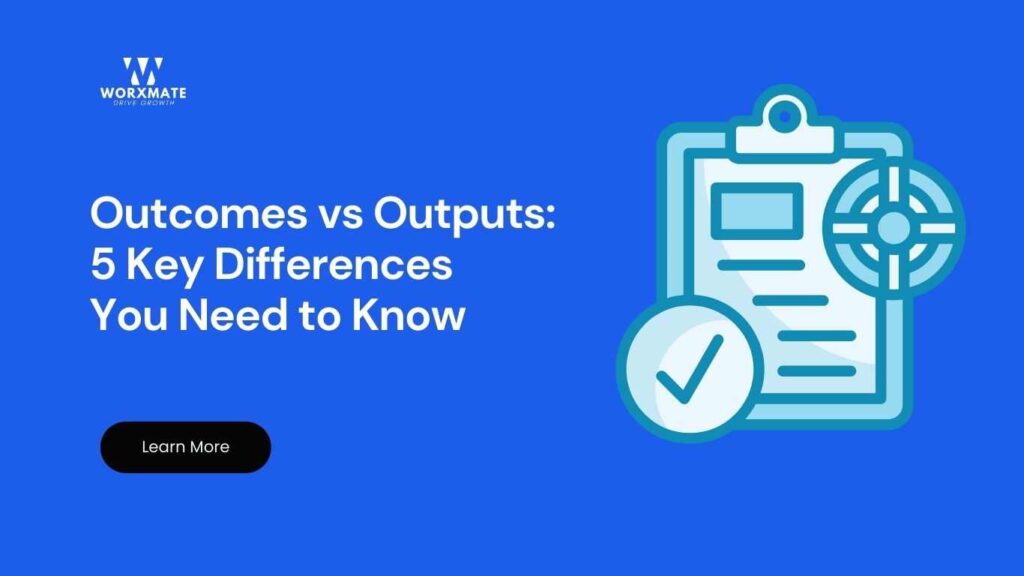When evaluating business performance, many organizations mistakenly focus on outputs rather than outcomes. While outputs measure productivity, outcomes determine success.
Understanding the difference between outcomes vs outputs is crucial for goal setting, performance tracking, and strategic decision-making.
This distinction is particularly important for businesses implementing OKRs (Objectives and Key Results) and performance management systems. By shifting focus from mere outputs to meaningful outcomes, organizations can drive sustainable growth and impact.
What Are Outputs?
Definition of Outputs
Outputs refer to the tangible deliverables or measurable activities produced by a team, department, or organization. They indicate effort and productivity but don’t necessarily reflect success or value creation.
Examples of Outputs
- Number of blog posts published per month
- Total sales calls made by a team
- Number of software updates released
- Customer service tickets resolved
While these metrics show activity, they do not measure the actual impact on business goals.
What Are Outcomes?
Definition of Outcomes
Outcomes represent the actual impact or results achieved due to specific activities. They indicate whether efforts have led to meaningful improvements, such as revenue growth, customer satisfaction, or employee engagement.
Examples of Outcomes
- Increased website traffic from content marketing efforts
- Higher customer conversion rates due to improved sales strategies
- Enhanced user satisfaction from software updates
- Reduced churn rate after customer service enhancements
By focusing on outcomes, businesses ensure that their efforts lead to significant and measurable improvements.
Outcomes vs Outputs: Key Differences
| Aspect | Outputs | Outcomes |
|---|---|---|
| Definition | Measurable deliverables or activities | The actual impact or results achieved |
| Focus | Productivity and effort | Value creation and success |
| Measurement | Quantitative (e.g., number of reports) | Qualitative and quantitative (e.g., customer retention rate) |
| Time Frame | Short-term goal | Long-term goal |
| Business Impact | Shows activity but not effectiveness | Indicates meaningful progress towards goals |
| Example | Publishing 10 blog posts | Increasing organic traffic by 20% |
Why the Distinction Matters
Many organizations fall into the trap of focusing solely on outputs, assuming that increased activity equates to success. However, without analyzing outcomes, businesses risk wasting resources on efforts that don’t drive real impact.
By shifting focus from output vs outcome, businesses can:
- Improve decision-making based on actual results.
- Align efforts with strategic objectives.
- Enhance accountability by measuring success beyond activity tracking.
Case Study: The Power of Outcome-Focused Strategies
A McKinsey study analyzed companies that prioritized outcomes over outputs and found that organizations using impact-driven OKRs experienced 30% higher revenue growth than those focusing only on productivity metrics.
For example, a global tech company shifted its performance measurement from feature releases (outputs) to user engagement and retention (outcomes). By refining its product strategy, the company saw a 25% increase in user retention and a 40% boost in subscription renewals.
Lessons Learned
- Activity without impact is meaningless – Releasing features is important, but ensuring they enhance user experience is critical.
- Outcome-driven OKRs improve business performance – Setting objectives linked to tangible business success leads to higher growth.
- Data-driven decision-making is key – Organizations should continuously track whether their efforts drive meaningful results.
Conclusion
Understanding outcomes vs outputs is vital for driving sustainable success in any organization. While outputs track progress, outcomes reveal whether efforts truly make an impact.
By prioritizing outcomes, businesses can align their strategies with long-term goals and create meaningful value for stakeholders. By using Worxmate’s OKR Software, organizations can transition from measuring productivity to achieving meaningful success.



